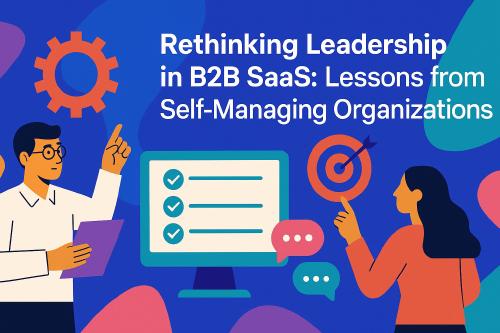Engineering Strategy: Actionable and Specific Guidance for Growing Engineering Teams (High-Purpose Environments, Part 6)
In the previous articles of my high-purpose environments series, we have explored the importance of vision, values, guiding principles, and engineering mission in creating a thriving and purpose-driven engineering culture. In this final article, I will delve into engineering strategy — a crucial element that translates high-level objectives into actionable and specific guidance for growing engineering teams.
I have read the advice to start bottom up with the strategies and then derive the vision from it. I can’t entirely agree with this approach. While it is tempting to start with the more straightforward and solution-oriented engineering strategy, I see the risk of narrowing down the solution space too much. This is micro-management via processes and documents. Not much better than giving direct orders. Isn’t it?
Therefore I suggest a top-down approach:
- Start with the vision.
- See what is missing for the team to operate efficiently and make aligned yet distributed decisions.
- Add values and guiding principles.
- See again what is missing.
- Specify a mission statement to give more guidance on how and to support vision, values, and guiding principles.
- Again, observe if the team needs more guidance.
- Write strategies if you really have to.
The reason why engineering strategy is the last aspect I cover in this six-article series is that I do not perceive it as that relevant. Most purpose-driven teams won’t need that detailed level of guidance if they are used to operating with considerable freedom and trust and have clarity about the bigger goals (vision and mission) that should be achieved.
The more detailed your guidance becomes, the more likely it is that it will become obsolete and confuse more than it helps. Furthermore, teams should be able to come up with the best strategies themselves once they know where they stand and what they should achieve.
Of course, everything depends on the context. The size of your company, the maturity, and where on the scale between “high creativity” and “high execution” you are. Be aware that too much strategy will kill creativity and innovation. It can give you a sense of high performance and alignment because everybody is shipping features, but that performance might be short-term when people go into tunnel vision for too long. Uncertainty can be scary and uncomfortable, but wrong confidence is worse.
A word about top-down: Note that top-down above is not referring to top-down in the hierarchical sense. While the initial direction can be set by top leadership, creating a high-purpose environment and working on vision and mission statements is a team activity that ideally involves people from various backgrounds, roles, and positions.
With all that words of warning, let’s dive into how to create effective engineering strategies.
Characteristics of an Effective Engineering Strategy
A strategy takes your organization from where it currently is to where it should be (the vision). It starts where the team currently is, the status quo, and shapes the way from there toward the vision. Thus, it is much more specific than vision statements and mission statements.
While a vision statement narrows down the problem space, the entire purpose of strategies is to narrow down the solution space. They reduce the number of possible solutions and therefore reduce decisive freedom. A strategy is opinionated on the solution, making decisions easier by limiting options.
To be effective, people need to buy the strategy. Your team will likely not accept and apply a strategy when unsure about its reasoning. Thus, the context and problem statement are essential background information for every strategy.
Ideally, a strategy is unsurprising to the larger team and more of a confirmation of the path chosen than a new direction. It serves to increase confidence about the way that everybody knows is the right one.
Creating an Effective Engineering Strategy
Creating an effective engineering strategy involves several steps that ensure the strategy aligns with your organization’s vision, mission, values, and guiding principles. Here’s a step-by-step guide to developing strategies that will resonate with your team and drive progress toward your long-term goals:
- Gather Input: Involve team members from various organizational roles and levels to gather diverse perspectives and insights. This collaborative approach fosters buy-in and ensures the strategy is grounded in the team’s collective experience and expertise. Another advantage of this collaborative approach is that you will revisit the vision and mission, thus deepening the understanding of high-level objectives.
- Analyze Current State: Assess the current state of your organization, identifying strengths, weaknesses, opportunities, and threats (SWOT analysis). Understanding the present situation provides a solid foundation for defining your strategy. Do not get lost in this step. Most engineering teams I have met had a decent understanding of their current state and their most pressing issues and risks.
- Identify Key Challenges: Based on your analysis, identify your engineering team’s most critical challenges in achieving the vision and mission. These challenges will help shape your strategy’s focus and priorities.
- Establish Strategic Priorities: Define the strategic priorities that address your identified key challenges. These priorities should align with the organization’s vision, mission, values, and guiding principles and serve as the basis for your tactical plans and actions.
- Develop Tactical Plans: For each strategic priority, develop specific, actionable plans that outline the steps, people, resources, and timelines required to achieve the desired outcomes. These plans should be detailed enough to provide clear guidance but flexible enough to adapt to changing circumstances.
- Communicate the Strategy: Communicate the engineering strategy to your team, ensuring everyone understands their role in executing the plan. Encourage open dialogue, feedback, and questions to promote understanding and alignment.
- Monitor and Adjust: Regularly review and assess the progress of your engineering strategy, adjusting as necessary to address new challenges, opportunities, or changes in the business environment. Continuously refine and improve your strategy based on feedback and performance data.
The effectiveness of your engineering strategies depends on their alignment with your organization’s vision, mission, values, and guiding principles, as well as the level of buy-in and commitment from your team. By involving your team in the strategy creation process and regularly reviewing and refining your strategy, you can build a strong foundation for long-term success and growth.
Ideally, strategizing isn’t a leadership activity but a team activity. With clarity about vision, mission, and guiding principles, the team should be able to develop a strategy. Leaders should take a supporting role and facilitate the process and help remove unclarity, if necessary.
Conclusion
In this final article of the high-purpose environments series, we have explored the role of engineering strategy in translating high-level objectives into actionable and specific guidance for growing engineering teams.
While detailed engineering strategies may not always be necessary, understanding their purpose and how to create effective ones can benefit teams operating in various contexts. A well-crafted engineering strategy should be flexible, adaptable, and focused on addressing the key challenges your team faces in achieving your organization’s vision and mission.
By developing and implementing effective engineering strategies with your team, you can provide them with the clarity, direction, and support they need to work in alignment with the engineering mission.
How are you creating and using engineering strategies in your company? Share your approach in the comments!





Use the share button below if you liked it.
It makes me smile, when I see it.